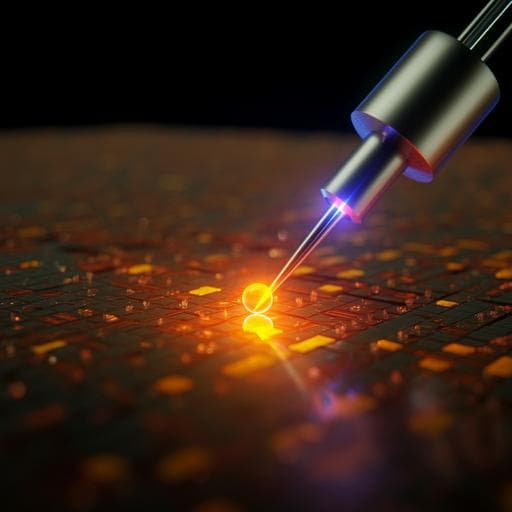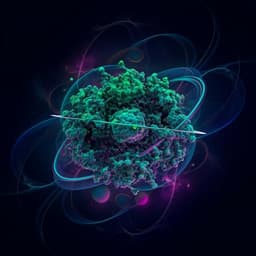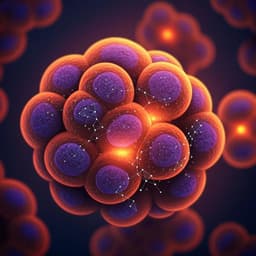
Chemistry
Atomic-precision control of plasmon-induced single-molecule switching in a metal-semiconductor nanojunction
Y. Park, I. Hamada, et al.
Discover how Youngwook Park and his team intricately manipulated single-molecule switching of peryleneanhydride on a silicon surface using a plasmon-resonant tip in this groundbreaking study. Explore the precision control achieved at 0.1-Å, revolutionizing nano-optoelectronics with applications in various technologies.
~3 min • Beginner • English
Introduction
The study addresses how to achieve atomic-precision control of single-molecule optoelectronic switching on a semiconductor surface using localized surface plasmons (LSPs). Nano-optoelectronics exploits molecular and nanoscale optoelectronic properties for devices such as sensors, LEDs, and photovoltaics, but conventional photoswitches typically require photochromic molecules. LSP-resonant nanojunctions can drive and control photochemical reactions at submolecular scales, yet prior realizations have been largely limited to metal-metal junctions. Metal-molecule-semiconductor nanojunctions have primarily been studied for far-field photovoltaic responses, and plasmon-mediated chemical reactions on semiconductors remain uncharacterized. This work proposes and demonstrates a plasmon-driven single-molecule switch on a Si(111)-7×7 surface using a plasmonic Ag tip and perylene-based molecules, aiming to expand plasmon chemistry to semiconductor platforms and enable sub-nanometer, atomically precise reaction control relevant for miniaturized optoelectronic devices.
Literature Review
The paper situates its contribution within several strands of prior research: (1) single-molecule photoswitches often rely on photochromic systems (e.g., azobenzene, spiropyran) interfaced with electrodes; (2) LSPs in nanojunctions can strongly enhance local fields and enable photochemical pathways inaccessible under far-field excitation, with STM+laser methods allowing real-space characterization and submolecular control of plasmon-induced reactions; (3) previous studies of metal-molecule-semiconductor junctions focused on far-field photocurrents and photovoltaic effects rather than plasmon-mediated chemistry; (4) PTCDA adsorption and structure on Si(111)-7×7 have been studied experimentally and theoretically, informing the choice of model system; and (5) mechanisms for plasmon-induced reactions include hot-carrier (HC) transfer and field/thermal effects, with several reports in metal-metal junctions pointing to HC-mediated pathways. The present work extends these themes to a metal–single-molecule–semiconductor junction and compares reactivity across chemically similar perylene derivatives (PTCDA, PMI, PDI).
Methodology
Experiments were conducted in UHV with a low-temperature STM (modified UNISOKU USM-1400) at 10 K and 78 K. A plasmon-resonant Ag tip was used to form nanojunctions with molecules (PTCDA, PMI, PDI) adsorbed on Si(111)-7×7. The Ag tips were fabricated by chemical etching followed by Ga-ion FIB milling to yield sharp, reproducible plasmonic properties; tip-apex resonance profiles were tuned via controlled contact/pulsing on Ag(111). Continuous-wave lasers at 532, 633, and 780 nm (p-polarized) were focused to the tip apex using an Ag-coated parabolic mirror (f=8 mm, NA=0.6) mounted on a five-axis piezo stage within the STM. Tip-enhanced Raman scattering (TERS) and STM-induced luminescence (STML) were collected via the same mirror to a grating spectrometer; long-pass filters matched to excitation wavelength were used for TERS. TERS acquisition time per spectrum was 3 s; STML was measured without laser under constant current. The laser focus was optimized via plasmon-induced downshift of field emission resonances on Ag(111). For current–time traces (I_STM) and TERS, the tip was positioned at molecule centers (unless specified), feedback opened, bias set, and the tip moved vertically (and laterally if needed) to defined sampling points. The tip–molecule gap distance d was referenced to the point of first contact with the OFF-state molecule (boundary between Zones III and IV determined from I–d curves). STM images were acquired at I_STM=50 pA, constant-current mode. Control experiments varied laser wavelength relative to tip plasmon resonance (determined by STML spectra) and laser power; traces were also recorded with laser off and across biases to test electron/field contributions. Molecules: PTCDA (578 K), PMI (598 K), PDI (568 K) evaporated from Knudsen cells onto room-temperature Si(111)-7×7 prepared by degas (1023 K) and flash anneal (1473 K). Theoretical methods: periodic DFT (STATE code) with rev-vdW-DF2 functional, ultrasoft/norm-conserving pseudopotentials (PBE-generated), plane-wave cutoffs 36/400 Ry, Si(111)-7×7 slabs (8 layers + vacuum), H-terminated bottom, Γ-point sampling, effective screening medium to remove spurious interactions, full relaxation to forces <2.5×10^-2 eV/Å (except fixed bottom). Adsorption energies defined as E_ads=E_tot(molecule/Si)-E_tot(molecule)-E_tot(Si). Finite-element method (FEM) simulations estimated plasmon-enhanced fields in Ag–Si junctions (details in Supplementary Note 7).
Key Findings
- PTCDA adsorbs at Si(111)-7×7 corner-hole sites, forming four O–Si bonds with adjacent Si adatoms; DFT indicates a nearly flat molecular geometry (contrary to previously predicted convex structures). STM shows a four-petal protrusion consistent with this binding.
- Under laser illumination with a plasmonic Ag tip, the junction exhibits two-state telegraph noise in I_STM, corresponding to reversible switching between OFF (tunneling) and ON (point-contact) states. TERS shows strong molecular peaks only in the ON state; bulk Si phonon at 520 cm^-1 appears as a reference.
- Tip-height dependent measurements define distinct regimes: Zone I (far) and Zone III (close) show exponential I–d behavior without TERS peaks (molecule in OFF state); Zone II exhibits telegraph noise and TERS peaks. In ON state, current is nearly invariant with tip height, consistent with point-contact formation.
- The ON-state occupation and TERS intensity depend sensitively on d, enabling control of forward/backward reaction rates with 0.1 Å precision. The ON-state geometry implies lifting of one anhydride half with estimated tilt of ~10–15° relative to the flat OFF configuration.
- Lateral tip position does not affect PTCDA switching (center vs edge), indicating attractive interaction between the tip apex and perylene core in the ON state.
- Chemical dependence: PMI (monoimide–monoanhydride) exhibits position-dependent switching—telegraph noise when the tip is over the anhydride side, none over the imide side; PDI (diimide) shows no switching at any position. The spatial separation between switchable and non-switchable regions in PMI is ~4 Å.
- DFT adsorption energies: E_ads (PTCDA) = −4.21 eV, (PMI) = −4.41 eV, (PDI) = −4.85 eV, indicating stronger Si–imide interaction than Si–anhydride, consistent with reactivity trends (anhydride active; imide inert).
- Necessity of light: switching disappears without laser irradiation, irrespective of V_bias.
- Plasmon resonance control: STML-defined resonances differ by tip—Tip 1 peaks around ~500 nm; Tip 2 around ~750 nm. Switching occurs under on-resonance excitation (Tip 1 at 532 nm; Tip 2 at 780 nm) and is absent off-resonance (Tip 1 at 780 nm). Switching also observed with λ_ext=633 nm for resonant tips.
- The switching rate scales linearly with laser power, arguing against thermal or purely field-driven mechanisms and against direct optical excitation of the molecule; data support a hot-carrier (HC) transfer mechanism akin to the Antoniewicz model.
- FEM shows the Si substrate contributes little to field enhancement; HCs thus originate predominantly from the plasmonic Ag tip, enhancing spatial selectivity compared to metal–metal gaps.
- Switching is independent of V_bias and not induced by tunneling electrons up to a few volts; high V_bias tends to damage the tip. Estimated plasmon-derived field <2.3×10^8 V/m, while DC fields from several hundred mV biases can be higher, yet do not drive the reaction, underscoring HC efficacy.
- PMI offers improved junction stability (imide side acts as anchor), reducing irreversible diffusion/pick-up events observed occasionally with PTCDA at small d.
Discussion
The findings demonstrate that plasmon excitation in an Ag–molecule–Si nanojunction can drive reversible, site-selective single-molecule switching via O–Si bond dissociation/reformation at the molecule–surface interface. The mechanism is best explained by hot-carrier transfer from the plasmonic tip into transient charged states of the adsorbate, which, upon relaxation, provide sufficient nuclear kinetic energy to traverse reaction barriers (Antoniewicz-type model). Linear laser-power dependence and resonance-matching requirements, together with insensitivity to V_bias and lack of switching without illumination, rule out alternative mechanisms based on direct tunneling electrons, thermal heating, or purely electromagnetic field effects.
Importantly, because the Si substrate is non-plasmonic in this geometry, the near-field enhancement is dominated by the tip, concentrating HC generation and transfer to the sub-nanometer vicinity of the apex. This yields high spatial selectivity and controllability, contrasting with metal–metal junctions where substrate plasmons and extended fields can drive less specific reactions over larger areas. Fine control over tip height modulates the double-well ground-state potential and barrier shape, tuning forward/backward rates with 0.1 Å precision.
Chemical substitution further modulates reactivity: anhydride groups are reactive and switchable, whereas imide groups are inert on Si(111)-7×7 despite similar adsorption geometries, as supported by stronger adsorption energies for imides. This demonstrates a route to tailor junction stability (e.g., PMI’s anchored imide) and function via molecular design. The results highlight metal–single-molecule–semiconductor junctions as a platform for atomic-scale optoelectronic control and selective plasmon chemistry.
Conclusion
This work establishes a controllable plasmon-induced single-molecule switch on a semiconductor surface using a plasmonic Ag tip and perylene-based molecules on Si(111)-7×7. The switch operates through reversible O–Si bond dissociation/formation, producing ON (point-contact) and OFF (tunneling) states that are unambiguously identified via simultaneous conductance and TERS measurements. Switching is activated only under LSP-resonant illumination, controlled with 0.1 Å tip-height precision, and proceeds via a hot-carrier transfer mechanism. Chemical tailoring reveals the anhydride group as reactive and the imide group as inert, enabling enhanced junction robustness (PMI) and pinpoint selectivity.
These results broaden plasmon chemistry to semiconductor platforms, demonstrating high selectivity, reversibility, and atomic-level control relevant to nano- and pico-optoelectronics. Future work can focus on molecular design to tune lifetimes and barriers (e.g., extending ON-state duration), exploring other semiconductor substrates and molecular anchors, and integrating such junctions into functional device architectures with on-chip plasmonic control.
Limitations
- The ON state has a short duration, restricting spectroscopic and mechanistic characterization of the ON-to-OFF pathway.
- High applied biases (several volts) do not induce switching and tend to irreparably damage the tip, limiting bias-dependent mechanistic probing.
- Occasional lateral diffusion or molecule pick-up by the tip occurred for PTCDA at small tip heights, potentially interrupting measurements; PMI mitigates but does not eliminate this risk.
- Limited field enhancement from the Si substrate confines plasmonic effects to the tip side, which, while beneficial for selectivity, may limit strategies relying on gap-mode field enhancement.
Related Publications
Explore these studies to deepen your understanding of the subject.







